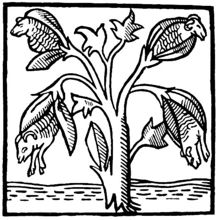Cotton is a soft, fluffy staple fiber that grows in a boll, or protective capsule, around the seeds of cotton plants of the genus Gossypium. The fiber is almost pure cellulose. Under natural condition, the cotton balls will tend to increase the dispersion of the seeds.
The plant is a shrub native to tropical and subtropical regions around the world, including the Americas, Africa, and India. The greatest diversity of wild cotton species is found in Mexico, followed by Australia and Africa.[1]Cotton was independently domesticated in the Old and New Worlds. The English name derives from the Arabic(al) qutn قُطْن, which began to be used circa 1400 AD.[2] The Spanish word, "algodón", is likewise derived from the Arabic.
The fiber is most often spun into yarn or thread and used to make a soft, breathable textile. The use of cotton for fabric is known to date to prehistoric times; fragments of cotton fabric dated from 5000 BC have been excavated in Mexico and the Indus Valley Civilization (modern day Pakistan). Although cultivated since antiquity, it was the invention of the cotton gin that so lowered the cost of production that led to its widespread use, and it is the most widely used natural fiber cloth in clothing today.
Current estimates for world production are about 25 million tonnes annually, accounting for 2.5% of the world's arable land. China is the world's largest producer of cotton, but most of this is used domestically. The United States has been the largest exporter for many years.[3]
There are four commercially-grown species of cotton, all domesticated in antiquity:
- Gossypium hirsutum – upland cotton, native to Central America, Mexico, the Caribbean and southern Florida, (90% of world production)
- Gossypium barbadense – known as extra-long staple cotton, native to tropical South America (8% of world production)
- Gossypium arboreum – tree cotton, native to India and Pakistan (less than 2%)
- Gossypium herbaceum – Levant cotton, native to southern Africa and the Arabian Peninsula (less than 2%)
The two New World cotton species account for the vast majority of modern cotton production, but the two Old World species were widely used before the 1900s. While cotton fibers occur naturally in colors of white, brown, pink and green, fears of contaminating the genetics of white cotton have led many cotton-growing locations to ban growing of colored cotton varieties which remain a specialty product.
History

Cotton plants as imagined and drawn byJohn Mandeville in the 14th century
Cotton was first cultivated in the Old World 7,000 years ago (5th millennium BC), by the inhabitants of Indus Valley civilization. Evidence of cotton cultivation has been found at the site of Mehrgarh, where early cotton threads have been preserved in copper beads.[4] Cotton cultivation became more widespread during the Indus Valley Civilization, which covered a huge swath of the northwestern part of the South Asia, comprising today parts of eastern Pakistan and northwestern India.[5] The Indus cotton industry was well developed and some methods used in cotton spinning and fabrication continued to be used until the modern industrialization of India.[6] Between 2000 and 1000 BC cotton became widespread in much of India.[7] For example, it has been found at the site ofHallus in Karnataka around 1000 BC. The use of cotton textiles had spread from India to the Mediterranean and beyond.[8]
Cotton fabrics discovered in a cave near Tehuacán, Mexico have been dated to around 5800 BC, although it is difficult to know for certain due to fiber decay.[9] Other sources date the domestication of cotton in Mexico to approximately 5000 to 3000 BC.[10]
The Greeks and the Arabs were not familiar with cotton until the Wars of Alexander the Great, as his contemporary Megasthenes told Seleucus I Nicator of "there being trees on which wool grows" in "Indica".
According to the Columbia Encyclopedia:[8]
Cotton has been spun, woven, and dyed since prehistoric times. It clothed the people of ancient India, Egypt, and China. Hundreds of years before the Christian era, cotton textiles were woven in India with matchless skill, and their use spread to the Mediterranean countries.
In Iran (Persia), the history of cotton dates back to the Achaemenid era (5th century BC); however, there are few sources about the planting of cotton in pre-Islamic Iran. The planting of cotton was common in Merv, Ray and Pars of Iran. In the poems of Persian poets, especially Ferdowsi's Shahname, there are references to cotton ("panbe" in Persian). Marco Polo (13th century) refers to the major products of Persia, including cotton. John Chardin, a French traveler of 17th century, who had visited the Safavid Persia, has approved the vast cotton farms of Persia.[11]
During the Han dynasty, cotton was grown by non Chinese peoples in the southern Chinese province of Yunnan.[12]
In Peru, cultivation of the indigenous cotton species Gossypium barbadense was the backbone of the development of coastal cultures, such as the Norte Chico, Moche and Nazca. Cotton was grown upriver, made into nets and traded with fishing villages along the coast for large supplies of fish. The Spanish who came to Mexico and Peru in the early 16th century found the people growing cotton and wearing clothing made of it.More

No comments:
Post a Comment